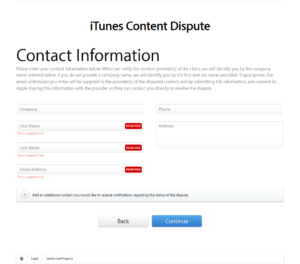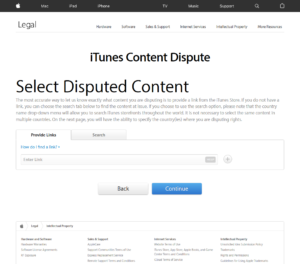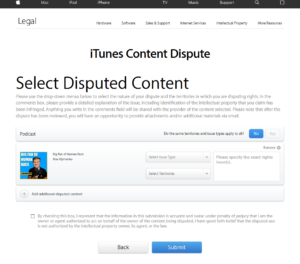Brand Protection & Content Protection
-Takedown Guides-
Apple
Apple IP Protection
A Guide To The iTunes Content Dispute Webform
iTunes – the music platform which led digitalization of the music industry. From the iPod to iTunes to Apple Music; Apple has revolutionized how music is consumed. In Apple’s current offering – between iTunes and Apple Music – they boast the most complete digital music offering. Through Apple platforms, music can be purchased and downloaded, or access to stream any track from the massive library of over 50 million songs can be purchased through a monthly subscription. With the iTunes software bundled in with Apple devices, including iPhone, MacBook and iPad it is easy to see how Apple Music has rapidly developed a large subscriber base to compete with Spotify, who remain Apple’s biggest competitor in Western markets. Spotify does have more paying subscribers globally, but Apple surpassed Spotify in the number of US subscribers in 2018.
No company is better at integrating hardware, software and intuitive design than Apple and the trend is set for further integration between devices and connected media. Therefore, rightsholders must understand how the iTunes Content Dispute system works, to create the space for their content to succeed in the Apple ecosystem.
Whilst Apple closely guards all their platforms and services, copyright infringement does occur on iTunes, with the unauthorised use of samples, territorial licence disputes or unauthorised digitization of old repertoire being the most common complaints. The iTunes Content Dispute form is fairly straightforward to complete, with Apple taking action 3-5 days after notification. The only requirement for submitting a takedown notice is to be either the rightsholder or an authorised agent of the rightsholder, this will be verified by ticking the final checkbox immediately before submitting the notice.
Furthermore, once the takedown notice has been approved, Apple will send a confirmation email, that warns the infringement may take up to 24 hours to be removed due to technical reasons. However, the infringement is normally removed once the confirmation email is sent. Apple also provides information on how to obtain data regarding any royalties paid. This helps the rightsholder(s) to resolve payment disputes quickly and equitably.
First thing to do after detecting an infringement is to copy the link. In the iTunes store, click on the arrow next to the price, this brings up a menu, then select “Copy Link”. Best practice is to save this link in a document or spreadsheet, as it will be needed when filing the takedown notice. Once the link of the infringing content is saved, click here to access the iTunes Content Dispute webform.
The webform has three mandatory boxes, “First Name”, “Last Name” and “Email Address”. Given the legal nature of this process, real, accurate details must be included in this section. Also, it is advised to provide company name in the “Company” box if relevant. There is a button to add additional contacts to receive notifications about the dispute, this can be useful to include a manager, publisher or other relevant agent. The required details for the additional contact are the same as the mandatory boxes for the reporter. Once the details are entered, click “Continue”.
Enter the link saved earlier from the iTunes store. The “Enter Link” box also has a “Help” button which can be used if there is any trouble in finding the link to report. The plus icon enables bulk submission. It is advised to separate infringing content by artist or album to avoid any confusion in the review process. The “Search” tab enables a search to be conducted from the reporting tool, covering all content; “Album”, “Audio Book”, “Movie”, “Music Video”, “Podcast”, “Song” or “TV Show”. The search is limited to regions, therefore this tool can be used to search detected infringing content in all the territories a rightsholder has the licence to, given the detected infringing was likely to be in their ‘home’ territory.
As advised above, it is best practice to group submissions, if so, then the “Do the same territories and types apply to all” option can be selected as “Yes”. This simplifies the process when bulk submitting notices. If just a single infringement is being submitted, or different categories, then the “Issue Type” and “Territories” must be individually assigned. Issue type includes “Name/likeness”, “Trademark”, “Artwork”, “Composition”, “Audio/Visual Master”, “Sound Recording” or “Other”. For all options a description specifying the right being asserted and ownership. For issues under “Other” a more detailed description may be necessary to aid the review process. Generally, for music, the “Sound Recording” option is used, and therefore stating who the copyright holder is, providing a link to Discogs can help identify the rightsholder. For the “Artwork” option in the dropdown, providing a link to the original aids the review process. For a trade mark claim, providing the trade mark registrations is necessary. In the “Territories” dropdown menu, the top option is “Worldwide”. Using this option enables efficient reporting, and subsequently removal from all regional variants of the iTunes store. If the distribution rights are owned by different agents, then selecting the precise territories is vital to ensure the notice is accurate.
There is only one checkbox to tick to finish the submission. As mentioned above, submitting a notice for copyright infringement is a serious issue and therefore it is advised to read all the statements carefully. By ticking the boxes the reporter, states the submission is accurate, the reporter is the owner or authorised agent to report the disputed content and the report is in good faith that the infringement is not authorised by the rightsholder, agent or law. If the submission is based on copyright, then the consideration of ‘fair use’ is implicit when ticking the checkbox. The concept of fair use is often mis-represented online, so it is advised to seek the advice prior to submitting the notification, if fair use is a potential contentious issue i.e. snippet of copyright protected sound recording used within a podcast is likely to be contentious than the unauthorised uploading of a full sound recording.



